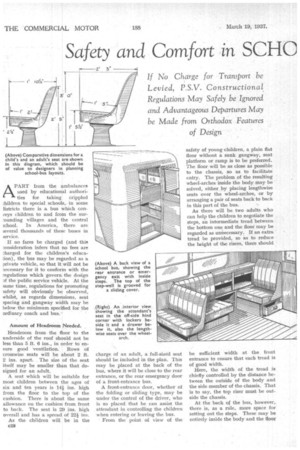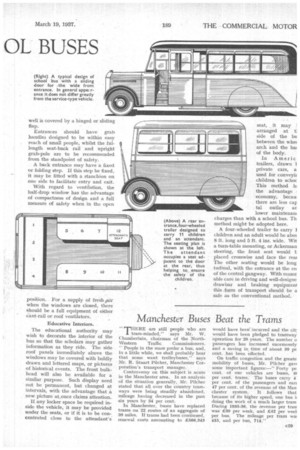Safety and Comfort in SCHO OL BUSES
Page 78

Page 79

If you've noticed an error in this article please click here to report it so we can fix it.
If No Charge for Tram port be Levied, P.S.V. Constructional Regulations May Safely be Ignored and Advantageous Departures May be Made from Orthodox Features
of Design
APART from the ambulances used by educational authorities for taking crippled thildren to special schools, in some listricts there is a bus which conmys children to and froth the surrounding villages and the central
school. In America, , there are several thousands of these buses in service.
If no fares be charged (and this tr.onsideration infers that no fees are harged for the children's education), the bus may be regarded as a private vehicle, so that it will not be aecessary for it to conform with the regulations which govern the design of the public service vehiCle, At the same time, regulations forL promoting safety will obviously be observed, whilst, as regards dimensions, seat spacing and gangway width may be below the minimum specified for the ordinary coach and bus.
Amount of Headroom Needed.
Headroom from the floor to the underside of the roof should not be less than 5 ft. 6 ins., in order to ensure good ventilation. Rows of crosswise seats will be about 2 ft. 2 ins. apart. The size of the seat itself may be smaller than that designed for an adult.
A seat which will be suitable for most children between the ages of six and ten years is 14i ins, high from the floor to the top of the cushion. There is about the same allowance on the cushion from front to back. The seat is 29 ins, high overall and has a spread of 24 ins.
As the children will be in the c28 charge of an adult, a full-sized seat should be included in the plan. This may be placed at the back of the bus, where it will be close to the rear entrance, or the rear emergency door of a front-entrance bus.
A front-entrance door, whether of the folding or sliding type, may be under the control of the driver, who is so placed that he can assist the attendant in controlling the children when entering or leaving the bus.
From the point of view of the safety of young children, a plain flat floor without a sunk gangway, seat platform or ramp is to be preferred. The floor will be as close as possible to the chassis, so as to facilitate entry. The problem of the resulting wheel-arches inside the body may be solved, either by placing lengthwise seats over the wheel-arches, or by arranging a pair of seats back to back in this part of the bus.
As there will be two adults who can help the children to negotiate the steps, an intermediate tread between the bottom one and the floor may be regarded as unnecessary. If an extra tread be provided, so as to reduce the height of the risers, there should be sufficient width at the front entrance to ensure that each tread is of good width. Here, the width of the tread is chiefly controlled by the distance between the outside of the body and the side member of the chassis. That is to say, the top riser must be outside the chassis.
At the back of the bus, however, there is, as a rule, more space for setting out the steps. These may be entirely inside the body and the floor
well is covered by a hinged or sliding flap.
Entrances should have grab handles designed to be within easy reach of small people, whilst the fuIlength seat-back rail and upright grab-pole are to be recommended from the standpoint of safety.
A back entrance may have a fixed or folding step. If this step be fixed, it may be fitted with a stanchion on one side to facilitate entry and exit.
With regard to ventilation, the half-drop window has the advantage of compactness of design and a full measure of safety when in the open position. For a supply of fresh cair when the windows are closed, there should be a full equipment of either Cant-rail or roof ventilators.
Educative Interiors.
The educational authority may wish to decorate the interior of the bus so that the scholars may gather information as they ride. The side roof panels immediately above the windows may be covered with boldly drawn and lettered maps, or pictures of historical events. The front bulkhead will also be available for a similar purpose. Such display need not be permanent, but changed at intervals, with the advantage that a new. picture at once claims attention.
If any locker space be required inside the vehicle, it may be provided under the seats, or if it is to be concentrated close to the attendant's
seat, it may 1 arranged at t] side of the bu between the whet arch and the bat of the body.
-
In Americ trailers, drawn 1 private cars, a used for conveyli children to schoc This method hi the advantage economy, becam there are less cap tal outlay an lower maintenant charges than with a school bus. Th method might be adopted here.
A four-wheeled trailer to carry 1 children and an adult would be aboi 8 ft. long and 5 ft. 4 ins. wide. Wit a turn-table mounting, or Ackerman steering, the front seat would placed crosswise and face the real The other seating would be long tudinal, with the entrance at the en of the central gangway. With reasor able care in driving and well-designe drawbar and braking equipmeni this form of transport should be a safe as the conventional method.
























































































































































